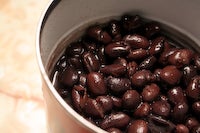BPA No Longer in Your Bottle

A can juicy black beans.
There has been a lot of buzz around BPA, the chemical Bisphenol A, which was used for years in clear plastic (polycarbonate) bottles. In the past few years, every outdor company that made bottles containing BPA dropped them. The latest was Sigg, which got rid of the BPA in its bottles in the midst of a scandal.
According to Consumer Reports, BPA-containing bottles and food can liners have been restricted in Canada and some U.S. states and municipalities due to a link with reproductive abnormalities, heightened risk of breast and prostate cancers, diabetes, and heart disease. According to Consumers Reports, the
Food and Drug Administration (FDA) is in the process of making a decision on what it deems a safe level of exposure to Bisphenol A (BPA).
While the FDA sorts out itsopinion on the topic, Consumer Reports took it upon themselves to test popular canned foods. What they found: in the categories of soups, juice, tuna,and green beans, “almost all of the 19 name-brand foods we tested contain some BPA.” Their report continues, “the canned organic foods we tested did not always have lower BPA levels than nonorganic brands of similar foods analyzed. We even found the chemical in some products in cans that were labeled “BPA-free.”
When we thought BPA was onlyin our waterbottles, it seemed almost manageable. But now that we know it’s ubiquitous (in one study at least, 95% of participants had traceabe BPA in their cells, it’s somewhat paralyzing. As reported in an article in
Care2Healthy & Green Daily, I learned that Federal guidelines currently put the daily upper limit of safe exposure at 50 micrograms per kilogram of body weight. It’s based on research that is 10-20 years old, not recent findings. More than 100 peer-reviewed studies have found BPA to be toxic at lower doses.
The Consumer Reports test results show that a 165-pound adult eating one serving of canned green beans could unknowingly ingest about 80 times the recommended upper daily limit. Kids eating several servings of canned foods each day could have BPA levels “approaching levels that have caused adverse effects in several animal studies,” according to Care2Healthy & Green.
What to do? Plain and simple–step away from the cans. Avoid the primary offender by eliminating canned food from your diet. Buy food preserved in glass or dried food instead. And FYI, not all plastics are BPA-containing. It’s #7 you have to look out for.
-Berne Broudy